m (The LinkTitles extension automatically added links to existing pages (<a rel="nofollow" class="external free" href="https://github.com/bovender/LinkTitles">https://github.com/bovender/LinkTitles</a>).) |
|||
| (One intermediate revision by the same user not shown) | |||
| Line 29: | Line 29: | ||
Different races use different kinds of Warp Reactors. The Federation primarily uses a matter/anti-matter reactor controlled by dilithium crystals to produce high energy warp plasma. Romulans use an artificial quantum singularity to do the same thing. Klingons have yet another method. The only requirement is that the reactor be able to produce high energy plasma at controlled frequencies. | Different races use different kinds of Warp Reactors. The Federation primarily uses a matter/anti-matter reactor controlled by dilithium crystals to produce high energy warp plasma. Romulans use an artificial quantum singularity to do the same thing. Klingons have yet another method. The only requirement is that the reactor be able to produce high energy plasma at controlled frequencies. | ||
The warp reactor of a Galaxy Class starship could produce in the range of 1000 terawatts of power at maximum output producing around 6 x 10^26 teradynes of force to propel the ship to Warp 9.2. | The warp reactor of a [[Galaxy Class Starship|Galaxy Class starship]] could produce in the range of 1000 terawatts of power at maximum output producing around 6 x 10^26 teradynes of force to propel the ship to Warp 9.2. | ||
By comparison the much smaller Intrepid Class starship had a warp core that produced in the range of 64 MW at maximum power output producing around 40000 teradynes of force to propel the ship to Warp 9.6. | By comparison the much smaller [[Intrepid Class Starship|Intrepid Class starship]] had a warp core that produced in the range of 64 MW at maximum power output producing around 40000 teradynes of force to propel the ship to Warp 9.6. | ||
The great discrepancy between the two is largely due to space craft size, but also due to advancements in warp field geometry and core design (see notes on enhancing a warp drive system). | The great discrepancy between the two is largely due to space craft size, but also due to advancements in warp field geometry and core design (see notes on enhancing a warp drive system). | ||
| Line 49: | Line 49: | ||
It is possible to increase warp power of an existing space craft (or of a space craft being constructed / refit) by [[Enhanced Warp Drive|enhancing it's warp drive system]]. | It is possible to increase warp power of an existing space craft (or of a space craft being constructed / refit) by [[Enhanced Warp Drive|enhancing it's warp drive system]]. | ||
[[Category:Propulsion]] | [[Category:Propulsion (FTL)]] | ||
Latest revision as of 04:49, 10 September 2017
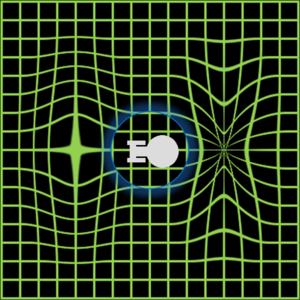
Warp drive is a technology to produce speeds in excess of the speed of light or c. A ships speed is referenced by their Warp Factor which is a short-hand method for referencing a multiple of light speed as it is represented in cochranes (named after the man who invented warp drive, Zefram Cochrane. One cochrane is roughly equal to the speed of light; the association is because any particular area of space has unique properties of gravity and energy meaning the the specific speed of light can vary from place to place so a cochrane is the ideal speed of light.
Faster than Light
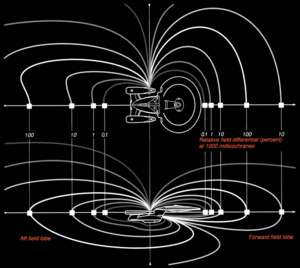
Faster than light propulsion is achieved through warping the fabric of spacetime to create a bubble around the ship so that the ship moves by moving the actual fabric of spacetime that it resides in. The warp drive system creates an intensely powerful magnetic field at specific frequencies of energy output and with a specific shape. The shape and energy output are critical in the magnetic field forming a subspace field around the ship. The subspace field then alters the geometry of spacetime. Creating a region of space time behind the ship that pushes the ship forward in addition to a region of spacetime in front of the ship that pulls the ship forward at the same time. This simultaneous push-pull allows stress to be distributed as evenly as possible around the ship.
-
Warp Power to Speed Graph
-
Two Ships Merging Warp Fields
-
Deep Space 9 using a Warp Bubble
It is important to note that because the application of a subspace field to alter the geometry of space-time also alters the physical laws governing the inside of the field travel at warp speed is not subject to the problems of time dilation associated with velocities approaching the speed of light.
Components of Warp Drive
A warp drive system consists of the following basic components, no matter what technology is used in the specifics these items are represented...
- Warp Reactor - Generates high energy 'Warp Plasma' to power the system
- Warp Nacelles - Contain the Warp Coils and Plasma Injectors
- Warp Coils - Powerful magnetic coils that when charged with high energy plasma create the magnetic / subspace field (commonly called a warp field)
- Plasma Injectors - Inject plasma from the Warp Reactor into the Warp Coils
- Plasma Conduits - Carry the plasma from the Warp Reactor to the Plasma Injectors
While there are a variety of different methods for creating each of these systems they are required to make warp drive possible. High energy plasma is used because it allows efficient transfer of the energy from the warp reactor to the coils the electrical energy, heat energy, and kinetic energy of the plasma is all used to sustain the reaction that makes warp drive possible.
Warp Reactor
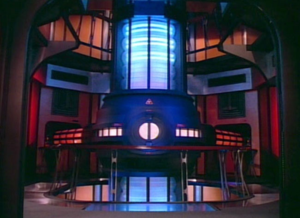
Different races use different kinds of Warp Reactors. The Federation primarily uses a matter/anti-matter reactor controlled by dilithium crystals to produce high energy warp plasma. Romulans use an artificial quantum singularity to do the same thing. Klingons have yet another method. The only requirement is that the reactor be able to produce high energy plasma at controlled frequencies.
The warp reactor of a Galaxy Class starship could produce in the range of 1000 terawatts of power at maximum output producing around 6 x 10^26 teradynes of force to propel the ship to Warp 9.2.
By comparison the much smaller Intrepid Class starship had a warp core that produced in the range of 64 MW at maximum power output producing around 40000 teradynes of force to propel the ship to Warp 9.6.
The great discrepancy between the two is largely due to space craft size, but also due to advancements in warp field geometry and core design (see notes on enhancing a warp drive system).
Warp Nacelles
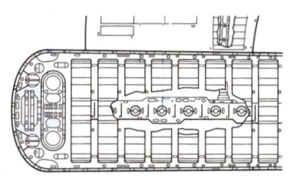
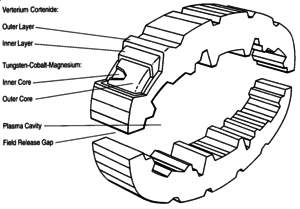
The process of creating a warp field is dangerous for living tissue. The magnetic field is required to be so strong that living tissue would (without shielding) atomize living tissue too close to it. As such a common design is to see the warp nacelles physically separate from the ship in long narrow structures connected by pylons, wings, or some such method to the main hull of the space craft. On Federation ships they almost always also include Bussard Collectors which collect interstellar hydrogen for potential use as fuel in the matter/anti-matter reactor.
Some 24th century designs have also used high capacity shielding to create a more compact design integrating the warp nacelles into the ships main space-frame. The shielding required increased exponentially with the size of the ship and the corresponding size of the warp drive system that powers its flight. Thus this method becomes less effective the larger the ship is.
How Fast is Fast?
Most ships are limited to low-warp, the warp factors below Warp 6. It has been discovered in the late 2360's that use of warp speeds higher than warp 6 can damage the fabric of space-time and use of high warp in a specific area frequently over time can create spacial rifts dangerous to space-flight.
Between Warp 1 and Warp 9, the scale is a predicable and easy to calculate curve of velocity in multiples of light speed. Beyond Warp 9 the scale turns asymptotic as it approaches Warp 10, or infinite velocity. The only ship ever to attain Warp 10 was a shuttle craft called Cochrane piloted by USS Voyager's Tom Paris in the Delta Quadrant and had disastrous effects on his DNA. The Warp Scale is roughly calculated as being Warp Factor to the 3 and 1/3 power giving the speed in multiples of light speed until Warp 9 is surpassed.
It is possible to increase warp power of an existing space craft (or of a space craft being constructed / refit) by enhancing it's warp drive system.


